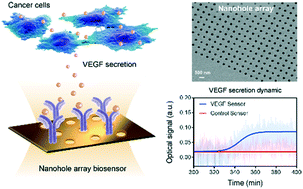Our official English website, www.x-mol.net, welcomes your
feedback! (Note: you will need to create a separate account there.)
Plasmonic nanohole array biosensor for label-free and real-time analysis of live cell secretion
Lab on a Chip ( IF 6.1 ) Pub Date : 2017-05-19 00:00:00 , DOI: 10.1039/c7lc00277g
Xiaokang Li 1, 2, 3, 4 , Maria Soler 1, 2, 3, 4 , Cenk I. Özdemir 1, 2, 3, 4 , Alexander Belushkin 1, 2, 3, 4 , Filiz Yesilköy 1, 2, 3, 4 , Hatice Altug 1, 2, 3, 4
Lab on a Chip ( IF 6.1 ) Pub Date : 2017-05-19 00:00:00 , DOI: 10.1039/c7lc00277g
Xiaokang Li 1, 2, 3, 4 , Maria Soler 1, 2, 3, 4 , Cenk I. Özdemir 1, 2, 3, 4 , Alexander Belushkin 1, 2, 3, 4 , Filiz Yesilköy 1, 2, 3, 4 , Hatice Altug 1, 2, 3, 4
Affiliation

|
Cell secretion dynamics plays a central role in physiological and disease processes. Due to its various temporal profiles, it is essential to implement a precise detection scheme for continuous monitoring of secretion in real time. The current fluorescent and colorimetric approaches hinder such applications due to their multiple time-consuming steps, molecular labeling, and especially the ‘snapshot’ endpoint readouts. Here, we develop a nanoplasmonic biosensor for real-time monitoring of live cell cytokine secretion in a label-free configuration. Our nanoplasmonic biosensor is composed of gold nanohole arrays supporting extraordinary optical transmission (EOT), which enables sensitive and high-throughput analysis of biomolecules. The nanobiosensor is integrated with an adjustable microfluidic cell module for the analysis of live cells under well-controlled culture conditions. We achieved an outstanding sensitivity for the detection of vascular endothelial growth factor (VEGF) directly in complex cell media. Significantly, the secretion dynamics from live cancer cells were monitored and quantified for 10 hours while preserving good cell viability. This novel approach of probing cytokine secretion activity is compatible with conventional inverted microscopes found in a common biology laboratory. With its simple optical set-up and label-free detection configuration, we anticipate our nanoplasmonic biosensor to be a powerful tool as a lab-on-chip device to analyze cellular activities for fundamental cell research and biotechnologies.
中文翻译:

等离子体纳米孔阵列生物传感器,用于无标记实时分析活细胞分泌
细胞分泌动力学在生理和疾病过程中起着核心作用。由于其各种时间特征,因此必须实施精确的检测方案以实时连续监测分泌物。当前的荧光和比色方法由于其耗时的步骤,分子标记,特别是“快照”终点读数而阻碍了此类应用。在这里,我们开发了一种纳米等离子体生物传感器,用于实时监测无标记配置中活细胞细胞因子的分泌。我们的纳米等离子体生物传感器由支持非凡光学传输(EOT)的金纳米孔阵列组成,可实现对生物分子的灵敏且高通量的分析。纳米生物传感器与可调节的微流控细胞模块集成在一起,用于在控制良好的培养条件下分析活细胞。我们在复杂的细胞培养基中直接检测血管内皮生长因子(VEGF)取得了出色的灵敏度。重要的是,在保持良好的细胞生存力的同时,对来自活癌细胞的分泌动力学进行了监测并定量了10小时。这种探测细胞因子分泌活性的新方法与在普通生物学实验室中发现的传统倒置显微镜兼容。凭借其简单的光学设置和无标记的检测配置,我们预计我们的纳米等离子体生物传感器将成为一种强大的工具,可作为芯片实验室设备来分析细胞活动以用于基础细胞研究和生物技术。我们在复杂的细胞培养基中直接检测血管内皮生长因子(VEGF)取得了出色的灵敏度。重要的是,在保持良好的细胞生存力的同时,对来自活癌细胞的分泌动力学进行了监测并定量了10小时。这种探测细胞因子分泌活性的新方法与在普通生物学实验室中发现的传统倒置显微镜兼容。凭借其简单的光学设置和无标记的检测配置,我们预计我们的纳米等离子体生物传感器将成为一种强大的工具,可作为芯片实验室设备来分析细胞活动以用于基础细胞研究和生物技术。我们在复杂的细胞培养基中直接检测血管内皮生长因子(VEGF)取得了出色的灵敏度。重要的是,在保持良好的细胞生存力的同时,对来自活癌细胞的分泌动力学进行了监测并定量了10小时。这种探测细胞因子分泌活性的新方法与在普通生物学实验室中发现的传统倒置显微镜兼容。凭借其简单的光学设置和无标记的检测配置,我们预计我们的纳米等离子体生物传感器将成为一种强大的工具,可作为芯片实验室设备来分析细胞活动以用于基础细胞研究和生物技术。监测并定量活癌细胞的分泌动力学10小时,同时保持良好的细胞活力。这种探测细胞因子分泌活性的新方法与在普通生物学实验室中发现的传统倒置显微镜兼容。凭借其简单的光学设置和无标记的检测配置,我们预计我们的纳米等离子体生物传感器将成为一种强大的工具,可作为芯片实验室设备来分析细胞活动以用于基础细胞研究和生物技术。监测并定量活癌细胞的分泌动力学10小时,同时保持良好的细胞活力。这种探测细胞因子分泌活性的新方法与在普通生物学实验室中发现的传统倒置显微镜兼容。凭借其简单的光学设置和无标记的检测配置,我们预计我们的纳米等离子体生物传感器将成为一种强大的工具,可作为芯片实验室设备来分析细胞活动以用于基础细胞研究和生物技术。
更新日期:2017-06-07
中文翻译:

等离子体纳米孔阵列生物传感器,用于无标记实时分析活细胞分泌
细胞分泌动力学在生理和疾病过程中起着核心作用。由于其各种时间特征,因此必须实施精确的检测方案以实时连续监测分泌物。当前的荧光和比色方法由于其耗时的步骤,分子标记,特别是“快照”终点读数而阻碍了此类应用。在这里,我们开发了一种纳米等离子体生物传感器,用于实时监测无标记配置中活细胞细胞因子的分泌。我们的纳米等离子体生物传感器由支持非凡光学传输(EOT)的金纳米孔阵列组成,可实现对生物分子的灵敏且高通量的分析。纳米生物传感器与可调节的微流控细胞模块集成在一起,用于在控制良好的培养条件下分析活细胞。我们在复杂的细胞培养基中直接检测血管内皮生长因子(VEGF)取得了出色的灵敏度。重要的是,在保持良好的细胞生存力的同时,对来自活癌细胞的分泌动力学进行了监测并定量了10小时。这种探测细胞因子分泌活性的新方法与在普通生物学实验室中发现的传统倒置显微镜兼容。凭借其简单的光学设置和无标记的检测配置,我们预计我们的纳米等离子体生物传感器将成为一种强大的工具,可作为芯片实验室设备来分析细胞活动以用于基础细胞研究和生物技术。我们在复杂的细胞培养基中直接检测血管内皮生长因子(VEGF)取得了出色的灵敏度。重要的是,在保持良好的细胞生存力的同时,对来自活癌细胞的分泌动力学进行了监测并定量了10小时。这种探测细胞因子分泌活性的新方法与在普通生物学实验室中发现的传统倒置显微镜兼容。凭借其简单的光学设置和无标记的检测配置,我们预计我们的纳米等离子体生物传感器将成为一种强大的工具,可作为芯片实验室设备来分析细胞活动以用于基础细胞研究和生物技术。我们在复杂的细胞培养基中直接检测血管内皮生长因子(VEGF)取得了出色的灵敏度。重要的是,在保持良好的细胞生存力的同时,对来自活癌细胞的分泌动力学进行了监测并定量了10小时。这种探测细胞因子分泌活性的新方法与在普通生物学实验室中发现的传统倒置显微镜兼容。凭借其简单的光学设置和无标记的检测配置,我们预计我们的纳米等离子体生物传感器将成为一种强大的工具,可作为芯片实验室设备来分析细胞活动以用于基础细胞研究和生物技术。监测并定量活癌细胞的分泌动力学10小时,同时保持良好的细胞活力。这种探测细胞因子分泌活性的新方法与在普通生物学实验室中发现的传统倒置显微镜兼容。凭借其简单的光学设置和无标记的检测配置,我们预计我们的纳米等离子体生物传感器将成为一种强大的工具,可作为芯片实验室设备来分析细胞活动以用于基础细胞研究和生物技术。监测并定量活癌细胞的分泌动力学10小时,同时保持良好的细胞活力。这种探测细胞因子分泌活性的新方法与在普通生物学实验室中发现的传统倒置显微镜兼容。凭借其简单的光学设置和无标记的检测配置,我们预计我们的纳米等离子体生物传感器将成为一种强大的工具,可作为芯片实验室设备来分析细胞活动以用于基础细胞研究和生物技术。































 京公网安备 11010802027423号
京公网安备 11010802027423号